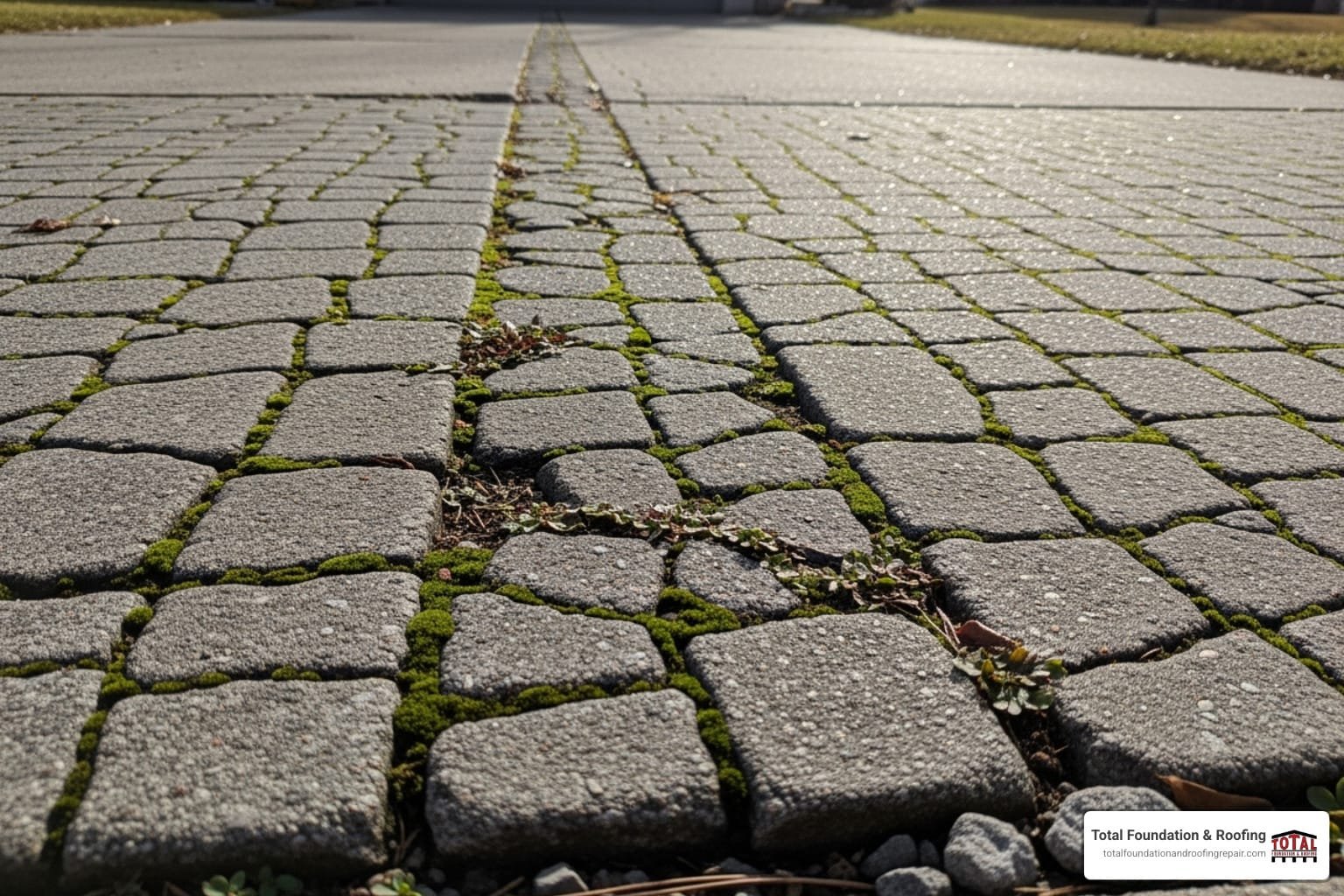Table of Contents
ToggleWhy Foundation Cracks Demand Your Immediate Attention
Spotting a foundation crack can be alarming, but understanding the issue is the first step toward protecting your home with reliable foundation and roofing solutions. Not all cracks spell disaster. While some are normal, others warn of major structural problems that demand immediate attention to fix foundation crack issues before they escalate.
Quick Foundation Crack Guide:
- Hairline (<1/8″): Usually normal settling. Monitor for changes.
- Medium (1/8″ to 1/4″): May need sealing with epoxy or caulk.
- Large (>1/4″): Requires immediate professional assessment.
- Horizontal: Always a red flag. Call a professional.
- Leaking: Address water source first, then seal the crack.
Foundation cracks come in different shapes and sizes, each telling a story about your home’s structural health. Some result from normal concrete curing, while others signal serious issues that could cost thousands if ignored. The expansive clay soils and extreme weather in the Texas Hill Country create unique challenges, causing foundations to shift and crack.
This guide will help you identify which cracks need a quick fix and which demand a professional. You’ll learn when to DIY and when to call for help to protect your home’s value. For comprehensive foundation repair services, an accurate diagnosis is the critical first step.
I’m Daniel Sowell, owner of Total Foundation & Roofing Repair. With over 18 years of experience helping Texas Hill Country homeowners, my team and I have seen every type of foundation problem and are dedicated to providing safe, permanent solutions.
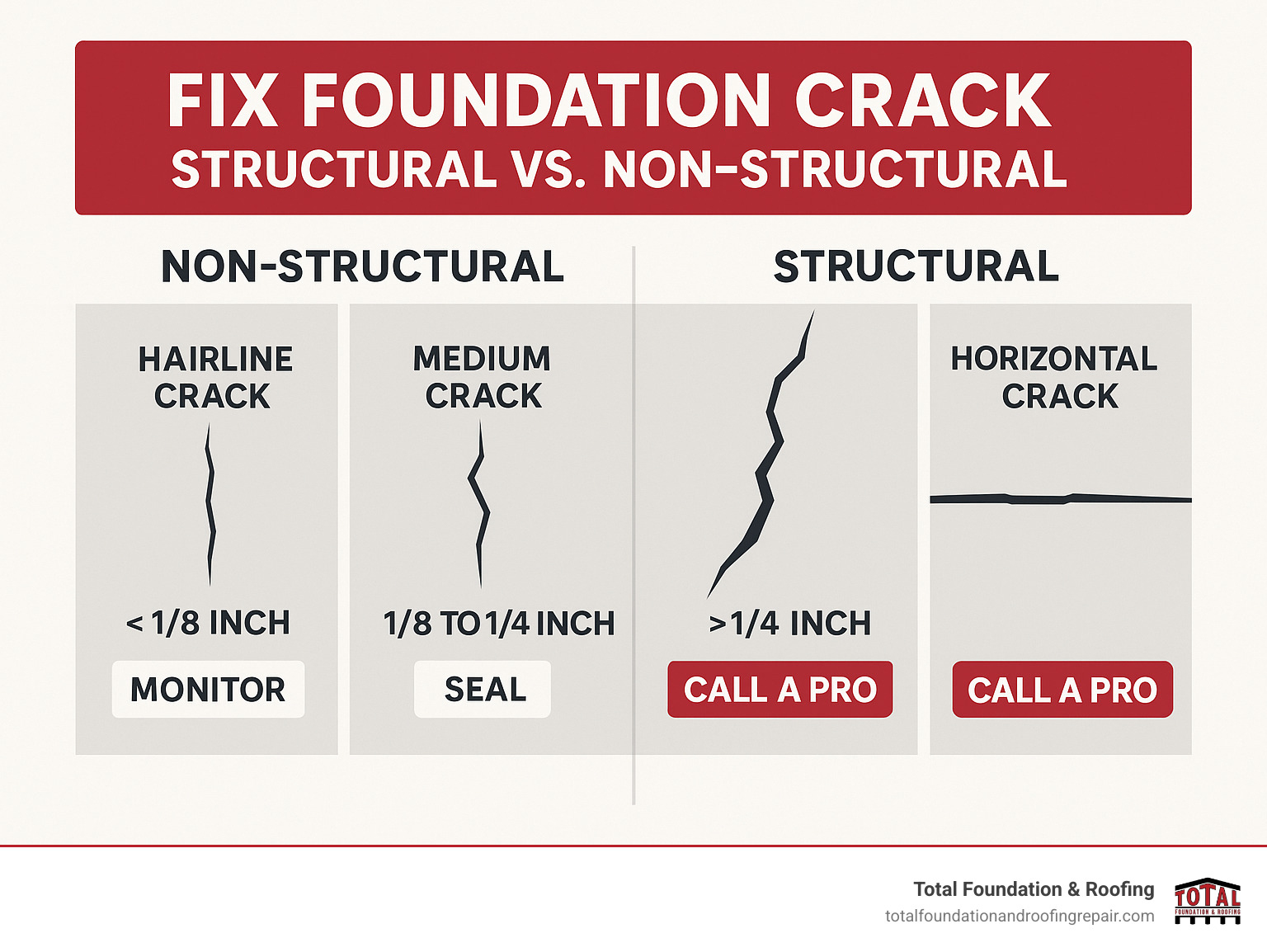
Decoding the Cracks: Types and Severity
Think of foundation cracks as your home’s way of communicating. Some are whispers about normal settling, while others are shouts about serious structural problems. Learning to interpret these signs can save you thousands of dollars.
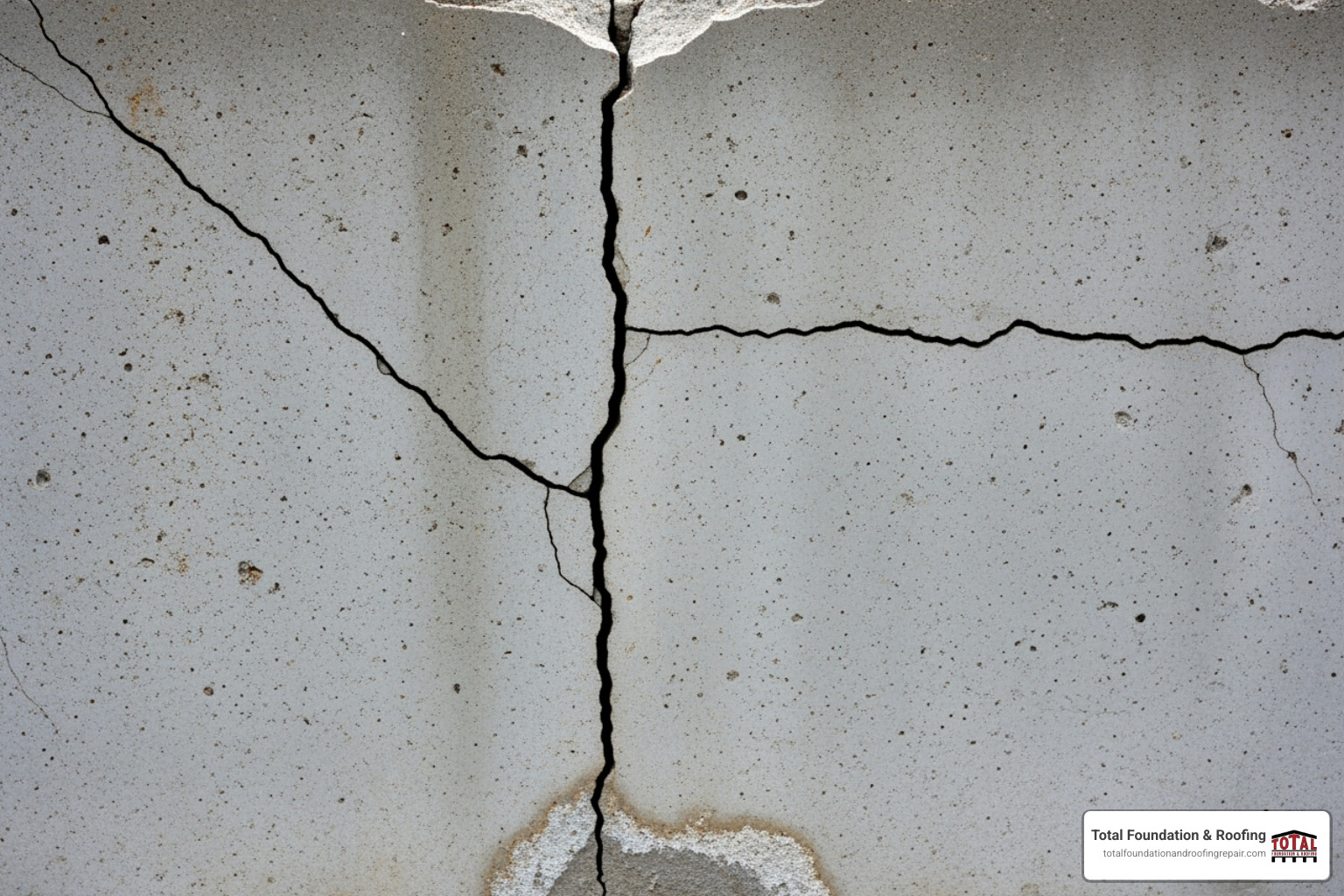
Crack Types and What They Mean:
- Vertical Cracks: Run up and down the wall. Often caused by concrete shrinkage or normal settling, especially if they are hairline (less than 1/8 inch wide).
- Diagonal Cracks: Angle across the wall (30-75 degrees). Also commonly from settling, but if one end is wider than the other, it could signal uneven settlement.
- Horizontal Cracks: Run parallel to the floor. These are the most serious, almost always indicating intense external pressure from soil and water against the foundation.
- Stair-Step Cracks: Follow the mortar joints in a block foundation. These typically point to differential settlement, where parts of the foundation move at different rates.
- Shrinkage Cracks: Small, hairline cracks that appear as concrete cures. These are generally non-structural and a normal part of the construction process.
How to Tell if a Foundation Crack is Serious
Determining a crack’s severity involves looking beyond its shape. The key is to assess multiple factors to understand if you’re dealing with a normal occurrence or a dangerous structural flaw.
| Feature | Normal Cracks | Dangerous Cracks |
|---|---|---|
| Appearance | Hairline, vertical/diagonal | Horizontal, stair-step, wide |
| Width | <1/8 inch | >1/4 inch |
| Growth | Stable, not changing | Actively growing or widening |
| Water Issues | Dry | Leaking or signs of moisture |
| Wall Shape | Flat | Bowing, bulging, or leaning |
Key Warning Signs:
- Crack Width: The 1/4-inch warning sign is a critical indicator. Cracks this wide or wider almost always signal a serious structural issue.
- Horizontal Cracks & Bowing Walls: These are red flags for severe structural stress from external pressure. A wall that is visibly bulging inward requires immediate professional help.
- Water Intrusion: Water entering through any crack, regardless of size, is a problem. It can lead to mold, rot, and further foundation decay.
- Active vs. Dormant Cracks: An active crack is one that is growing in length or width. You can monitor this by marking the ends with a pencil and dating it. If it grows, it’s an active problem.
- Other Signs: Look for related issues in your home, such as uneven floors, sticking doors or windows, or gaps between walls and ceilings. These are classic signs that the foundation is shifting.
Here in the Texas Hill Country, our expansive clay soils are notorious for causing foundation movement. Understanding these local conditions is key to correctly diagnosing crack patterns. According to The National Association of Home Builders (NAHB) standards, any active or wide wall cracks typically warrant professional attention.
The Root of the Problem: Common Causes of Foundation Cracks
Understanding why a crack appears is as important as identifying it. Foundation problems are often symptoms of a larger issue with the soil or water around your home.
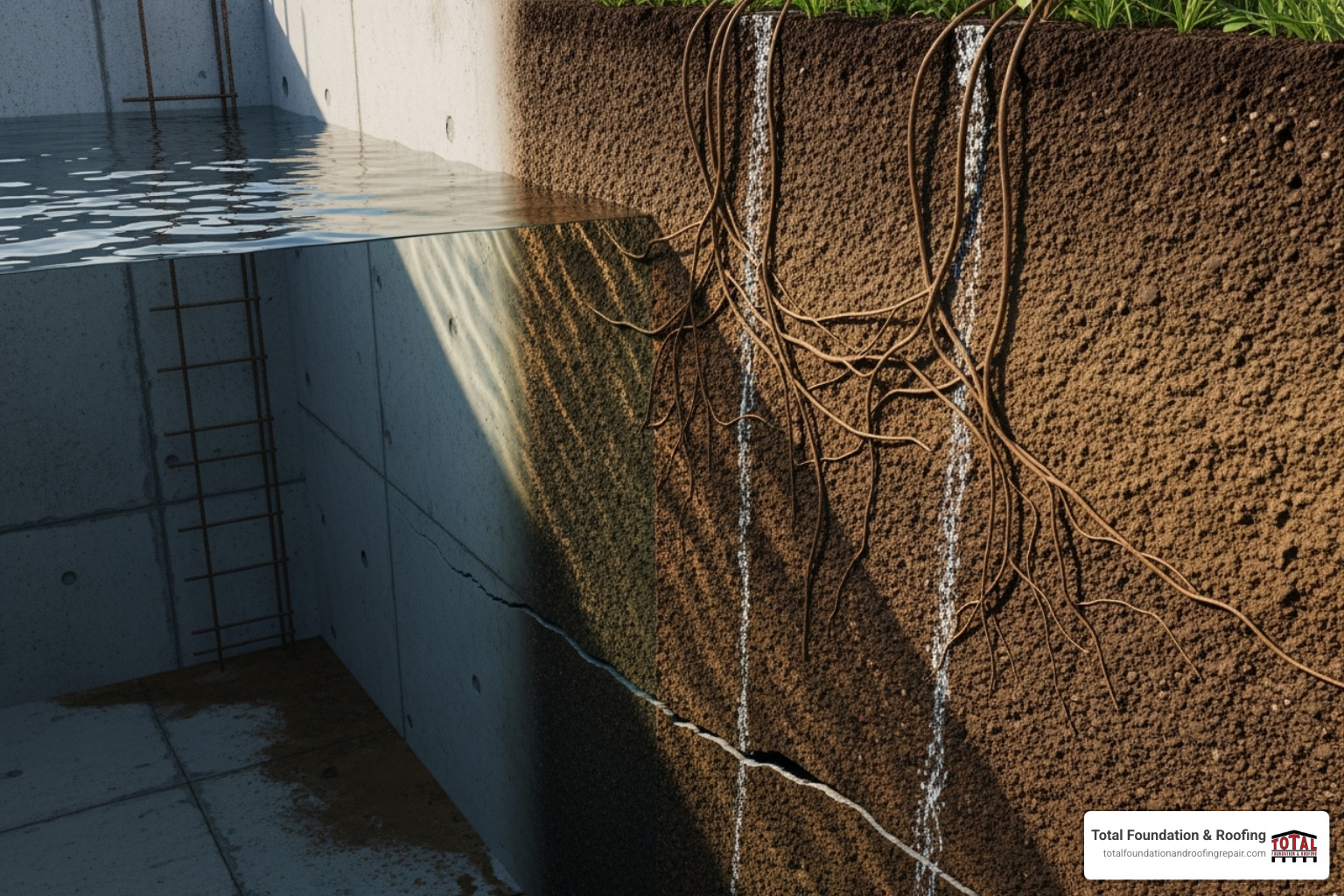
- Foundation Settlement: All homes settle, but uneven (or differential) settlement causes stress that cracks foundations. This often happens if soil wasn’t compacted properly during construction.
- Concrete Shrinkage: As new concrete cures and dries, it naturally shrinks. This process commonly creates small, non-structural hairline cracks within the first year.
- Hydrostatic Pressure: When the soil around your foundation becomes saturated with water, it exerts immense inward pressure. This force is a primary cause of dangerous horizontal cracks and bowing walls.
- Expansive Soils: Clay soils, common in our area, expand dramatically when wet and shrink when dry. This constant cycle of expansion and contraction puts tremendous stress on a foundation, causing it to shift and crack. You can see how different soil compositions across the country create unique building challenges.
- Poor Drainage & Gutter Issues: If water isn’t directed away from your home, it pools against the foundation. Clogged gutters or downspouts that are too short are major culprits, dumping water exactly where it can do the most damage.
- Tree Roots: Large tree roots can absorb moisture from the soil, causing it to shrink and the foundation to settle. Growing roots can also exert direct pressure on foundation walls.
- Poor Construction: Sometimes, the problem dates back to the initial build, with issues like an improper concrete mix or inadequate soil preparation.
Why Texas Hill Country Foundations Are Unique
Living in the Texas Hill Country means your foundation faces a unique set of challenges. Our geology and climate create a perfect storm for foundation problems.
Our region’s expansive clay soil is highly reactive to moisture. During our frequent drought conditions, this soil shrinks, pulling away from the foundation and creating voids. When heavy rains return, the soil swells, pushing against the foundation with incredible force. This constant cycle of stress is why local expertise is crucial when you need to fix foundation crack issues.
A repair method that works in stable soils elsewhere may fail in our volatile conditions. We’ve spent years understanding these local nuances, whether we’re handling foundation repair in New Braunfels or right here in Kerrville. Choosing a contractor who understands this unique soil-foundation interaction is essential for a lasting repair.
Your Action Plan: Methods to Fix Foundation Crack Issues
Once you’ve assessed the crack, it’s time for a repair strategy. The big question is whether to tackle it yourself or call a professional. The answer depends on the crack’s severity, the risks involved, and your skill level. Attempting to fix foundation crack issues beyond your expertise can turn a manageable problem into a costly disaster.
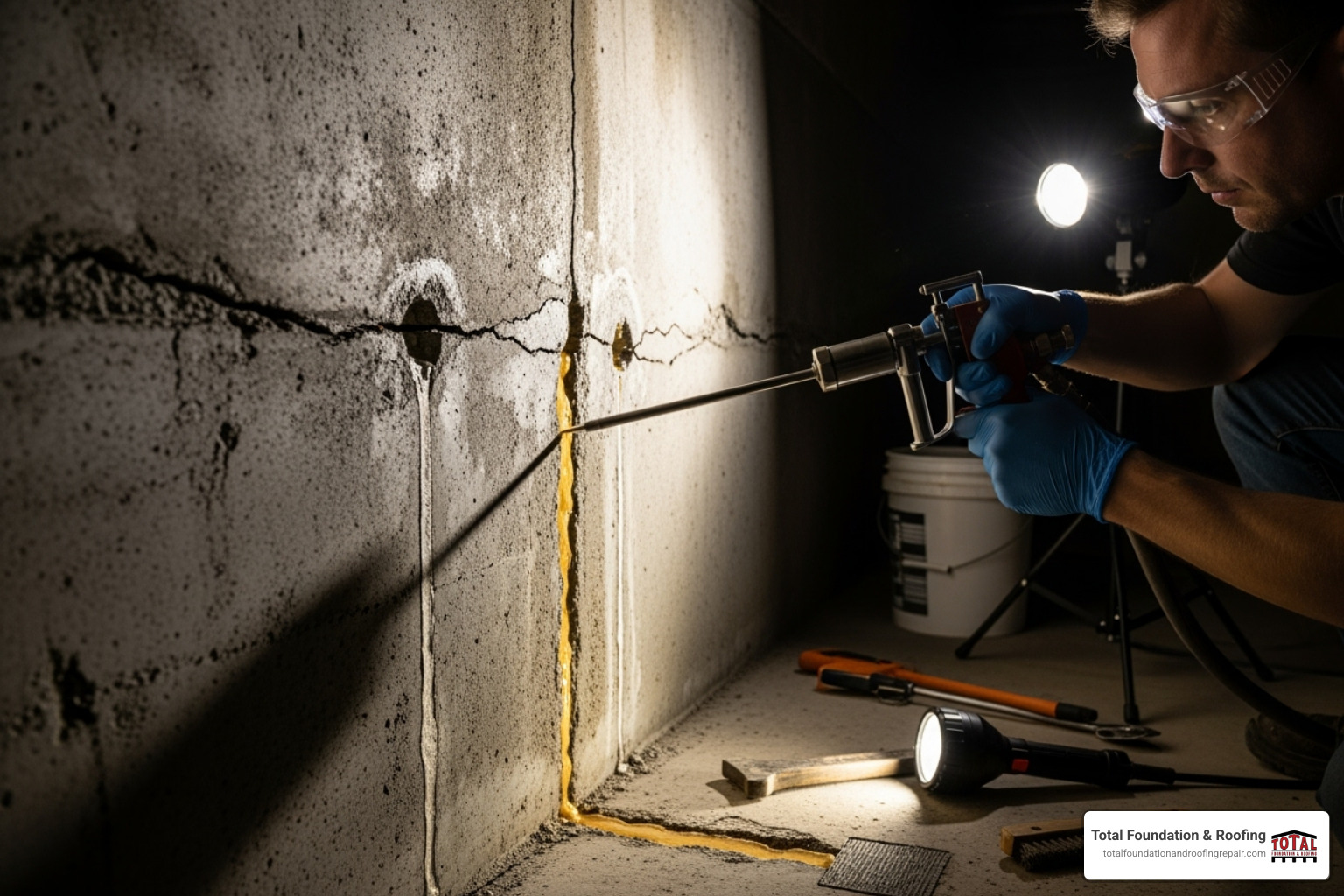
DIY Foundation Crack Repair: When and How
DIY repair is only suitable for minor, non-structural issues. You can likely handle hairline cracks that are stable (not growing), vertical or diagonal cracks less than 1/8 inch wide with no water seepage, and small surface cracks.
For these minor jobs, you can use concrete caulking compounds for a flexible seal or hydraulic cement for a quick patch. The most robust DIY option is an epoxy injection kit, which can bond the concrete together. However, DIY repairs come with significant risks. Misdiagnosing a structural problem as a minor one can lead to catastrophic failure. An improper seal can trap moisture or fail entirely, leading to more expensive repairs later.
A DIY epoxy injection process generally involves:
- Surface Prep: Clean the crack with a wire brush and vacuum out all debris.
- Port Installation: Attach injection ports along the crack every 6-12 inches.
- Surface Sealing: Apply a two-part epoxy sealer over the entire crack surface to hold the injection epoxy in place.
- Injection: Once the sealer cures, inject epoxy into the ports, starting from the bottom until it fills the crack completely.
Professional Solutions for Lasting Results
When you’re dealing with structural cracks, active leaks, or any of the major warning signs, professional intervention is essential. Our foundation repair services are designed to address the root cause, not just the symptom, ensuring a durable, long-term solution backed by a warranty.
Professionals use industrial-grade materials and specialized techniques:
- High-Pressure Epoxy Injection: This method welds the concrete back together, restoring its original structural strength. It’s far more effective than DIY kits.
- Polyurethane Foam Injection: Ideal for actively leaking cracks, this foam expands to create a flexible, watertight seal, even on wet surfaces.
- Carbon Fiber Reinforcement: For bowing walls, these incredibly strong straps are bonded to the wall to prevent further inward movement and provide structural stability.
- Piering and Underpinning: For severe settlement, steel piers (push or helical) are driven deep into stable soil to support and lift the foundation. This is a complex structural repair that requires an expert, especially for homes with basements that need specialized basement crack repair.
The bottom line: minor cosmetic cracks may be a DIY job, but anything structural demands a professional. When in doubt, an expert assessment is your safest and most cost-effective choice.
Calling in the Cavalry: When to Hire a Professional
No one wants to spend money unnecessarily. But with foundation problems, a DIY attempt on a serious issue can cost you thousands more in the long run. The value of a professional inspection goes far beyond just patching a crack; it’s about getting an accurate diagnosis of what’s happening beneath your home.
An expert evaluation provides peace of mind and protects your long-term home value. Professional repairs with proper documentation and warranties show potential buyers that the problem was handled correctly. This is critical when it comes time to sell.
Red Flags: Signs of Serious Structural Damage
Some problems are clear signals to call a professional immediately. These are not weekend projects; they are signs of serious structural distress.
- Wide Cracks: Any crack over 1/4 inch wide, especially if it’s growing.
- Horizontal Cracks: These almost always indicate dangerous external pressure on your foundation.
- Stair-Step Cracks: Wide, growing cracks in a block foundation signal uneven settlement.
- Bulging or Bowing Walls: Any visible inward curve in a foundation wall means it’s under severe stress and could fail.
- Sticking Doors and Windows: When the house frame is thrown out of alignment by a shifting foundation, doors and windows begin to stick or show gaps.
- Sloping or Uneven Floors: This suggests the foundation is no longer providing stable, uniform support.
- Gaps: Look for new gaps between walls and ceilings or floors.
The Cost to Fix a Foundation Crack: What to Expect
Repair costs vary widely based on the problem’s severity, the method required, and accessibility. Here’s a general breakdown of what to expect:
- DIY Kits: For minor, non-structural cracks, kits cost between $75 and $225.
- Professional Injection: For non-structural cracks, professional sealing typically ranges from $500 to $2,500.
- Structural Repair: Costs increase significantly here. Carbon fiber reinforcement might cost $1,200 to $5,000 per section. More extensive repairs like steel piering can range from $10,000 to $50,000 or more, depending on the number of piers needed.
- Exterior Repair with Excavation: If digging is required to address hydrostatic pressure, costs can start around $15,000.
The cost of inaction is almost always higher than the cost of a timely repair. A small crack ignored today can become a major structural failure tomorrow. Every situation is unique, which is why a professional assessment is so important. For an accurate price custom to your home, Request a Free Estimate and let our experts show you exactly what you’re dealing with.
Prevention is the Best Medicine: Protecting Your Foundation
An ounce of prevention is worth a pound of cure, especially with your home’s foundation. Proactive maintenance can dramatically reduce your risk of serious cracks and save you thousands. Most preventative strategies are simple and focus on one main goal: controlling water.
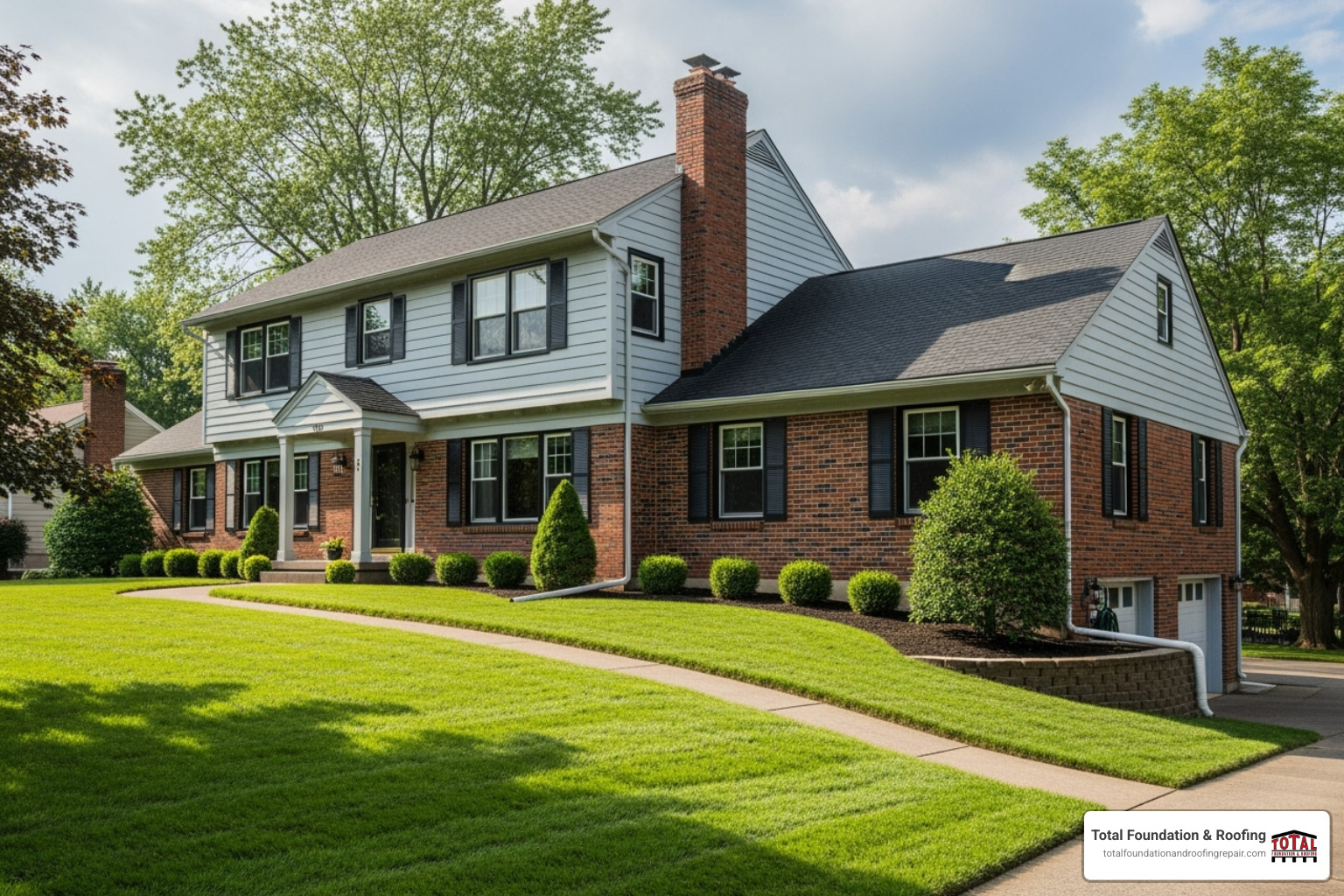
How Proper Drainage and Grading Can Save Your Foundation
Water is your foundation’s number one enemy. Managing it effectively is your best defense.
- Grade Your Landscape: The ground around your foundation should slope away from the house—a drop of about 6 inches over the first 10 feet is ideal. This gentle slope directs rainwater away from your foundation walls.
- Maintain Gutters and Downspouts: Clean your gutters regularly to prevent overflows. Crucially, ensure your downspouts extend at least 5 to 10 feet away from the house. This simple step channels thousands of gallons of water away from the foundation.
- Install French Drains: In areas with persistent water problems, a French drain can intercept water before it ever reaches your foundation. This is a more involved project but highly effective.
- Manage Tree Roots: Large trees planted too close to the house can draw moisture from the soil or exert pressure on the foundation. Consider installing root barriers for mature trees near your home.
Routine Foundation Inspections
An annual self-inspection is like a physical for your house, helping you catch problems early.
- Check for Cracks: Look for new cracks or changes in existing ones. Use the pencil-and-date method to monitor for growth.
- Look for Moisture: Check your basement or crawl space for dampness, water stains, or musty smells.
- Inspect Grading and Gutters: Ensure the soil still slopes away from the house and that downspouts are clear and properly directed.
- Watch for Interior Signs: Keep an eye out for sticking doors or windows and new gaps in drywall or trim. These are often the first signs of foundation movement.
Prevention gives you control. By actively protecting your investment with these simple maintenance tasks, you can avoid reacting to expensive emergencies down the road.
Conclusion
We’ve covered how to decipher foundation cracks, understand their causes, and choose the right repair method. The key takeaway is simple: identify, assess, and act. Think of foundation cracks as warning lights. Some are minor reminders, like hairline vertical cracks from normal settling. Others are flashing red alerts demanding immediate attention, like horizontal cracks or any crack wider than a quarter-inch.
Minor cracks can often be a manageable DIY project, but only if they are stable, non-structural, and not leaking. Misdiagnosing a serious structural issue can turn a simple professional repair into a five-figure nightmare.
Structural issues always require an expert. When you see horizontal cracks, bowing walls, or water intrusion, you’re dealing with forces that can compromise your home’s stability. In the Texas Hill Country, our unique climate and expansive clay soils make professional expertise even more critical for a lasting solution.
Protecting your home’s integrity means being proactive. Monitor your foundation, manage drainage, and know when to seek help. An annual inspection can save you thousands in the long run.
Don’t let a small crack become a major problem. Every day you wait, the damage could be worsening. For a professional evaluation and the peace of mind that comes with a permanent fix, explore our expert Crack Repair services. Your home is your biggest investment—let us help you protect it.


